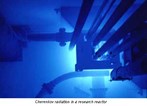Electron Café by John Glenn: Things that glow in the dark

In late October, a team of experts was sent to a landfill at the Paducah, KY uranium enrichment facility. This was a response to a memorandum by a plant health physicist about reports that a "blue glow" had been seen periodically since the early 1980s. The health physicist's Oct. 19 memo raised the possibility that the blue glow was indicative of a nuclear criticality reaction.
My immediate reaction was that it was foolish to believe that the blue glow had anything to do with radiation. My reasoning was sound, but on reflection, I realized that my first reactions were arrogant and indicative of the communications gap between experts and the affected public.
There are radioactive phenomena that cause blue glows. The public has been told stories of radioactive materials that "glow in the dark." Thus the public deserves a serious explanation and not a quick dismissal.
U.S. Department of Energy (DOE) officials performed rather well in response to this memo. They made measurements in the area that conclusively rule out nuclear reactions of the type and magnitude needed to produce a visible effect.
Further monitors and sensors already in place would have detected even a small nuclear reaction anywhere on the plant's grounds and no such "spike" in radiation levels had been recorded. When asked why they investigated the site when they were confident that nothing could have occurred, officials appropriately replied, "If someone raises a safety concern, it gets reviewed, no matter what the history is ..."
DOE officials said the glow could have been hydrogen or methane from a water-induced chemical reaction. Another possibility was light from self-igniting aluminum shavings.
What causes radioactivity to glow? There are basically three ways that radioactivity can cause a glow:
Thermal heat—Hot objects can glow based on their temperature. A blue glow would represent very high temperatures and extremely high concentrations of radioactivity. Not a likely scenario in a burial pit, and the thermal effects would persist and remain observable.
Fluorescence—The emission of visible light after the electrons in a material are excited by radiation from radioactivity decay or other source of energy. Illuminated dial watches are an example. Old style watches used radium mixed with a chemical that exhibited fluorescence. Radium dial watches have a fairly high level of radiation that can escape through the watch casing.
Modern watches use tritium as the source of radiation. The weak radiation from tritium can not get through the watch casing so radiation levels are very low. However, not all "glow in the dark" consumer items contain radioactive material. Glow in the dark toys do not contain radioactive material but have a fluorescence that decays with time after a material is exposed to visible light or a chemical reaction. The glow at the burial pit may be due to chemical fluorescence.
Cherenkov Radiation—This is the blue glow observed in the water surrounding nuclear reactors. The blue glow comes from beta particles (fast electrons) that are emitted by radioactive materials produced by fission. Blue light predominates over longer wavelengths of light because of the way the radiation is produced.
Cherenkov radiation only occurs when the initiating radiation (beta particles as a rule) is traveling faster than the speed of light in the material. Cherenkov radiation will not occur in a vacuum or in air where the speed of light is equal to the Einstein's theoretical speed of light.

The health physicist feared Cherenkov radiation might be the cause of the glow at Paducah. Since the glow was only rarely present, the cause would have to be an intermittent criticality caused by water mixing with enriched uranium.
If this were the case, the radiation levels would be so high as to set every radiation detector at the facility. Only an infinitesimally small fraction of the energy from radioactivity is released as Cherenkov radiation.
If this were not true, we could use glasses of water rather than sensitive electronic detectors to look for radiation. As a general rule, if you see a blue flash from a criticality, you have received a large radiation exposure.
Kudos to the DOE for investigating even though their experts "knew" there could not be anything there.
